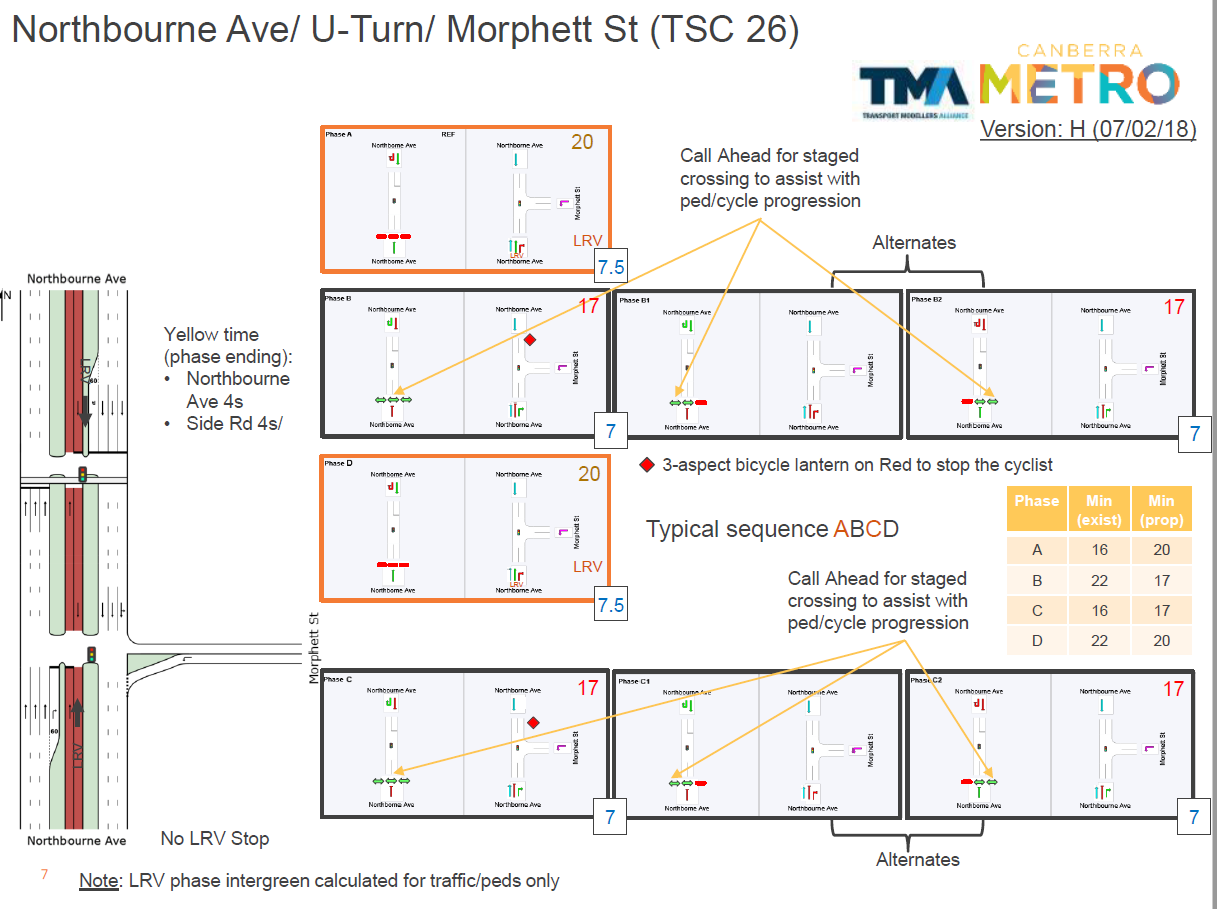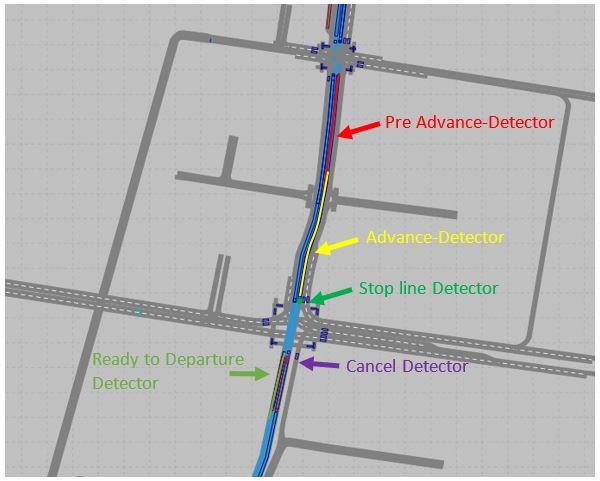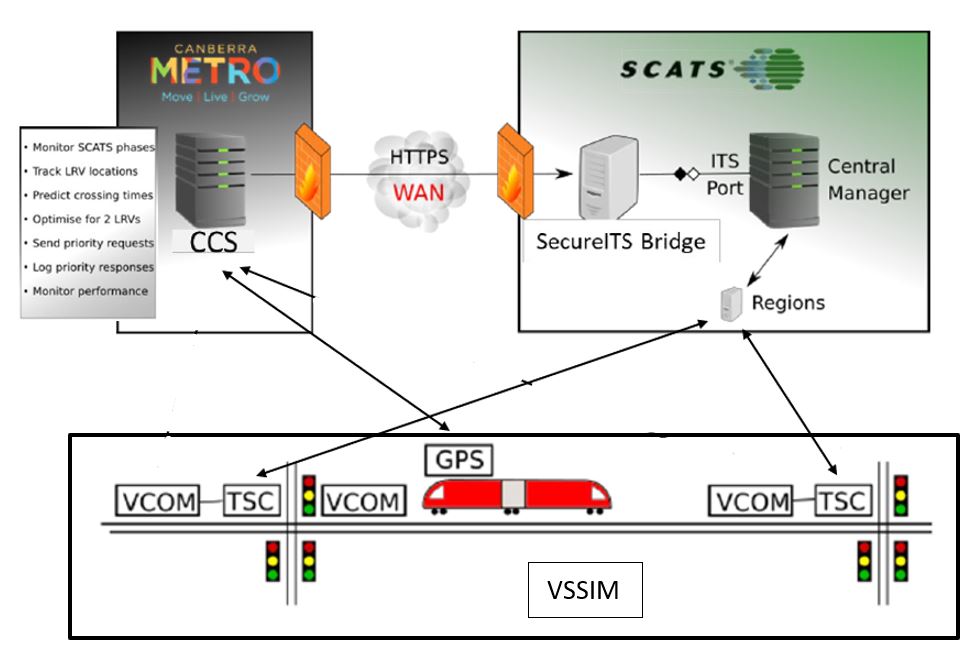Client: Canberra Metro
Location: Canberra, ACT
Period: 2015 – 2019
The Capital Metro Light Rail Stage 1 is a 12-kilometre line that connects the rapidly developing Gungahline to City corridor, including 26 signalised intersections and 13 LRV (Light Rail Vehicle) stops.
TMA has been involved on the project since 2015, providing specialist traffic and transport solutions:
- Traffic Signal Design
- We designed traffic signal phasing and controller timings for a safer, efficient road network with light rail priority principles to minimise journey times
- We developed and tested traffic controller personalities (logic) for 26 intersections with a host of innovative light rail safety and priority features.
- We created Controller Operation Specifications documenting full signal controller features and operation specifications for each intersection.
2. Operational Modelling
-
- We provided VISSIM operational modelling using VisVAP (vehicle actuated programming) to assess light rail and road network performance.
- We developed a SCATSIM VISSIM model that directly interfaces with SCATS and Canberra Light Rail Central Control System to truly reflect real world operation.
Traffic Signal Design
Traffic Signal Operation Principles
Our approach to optimising traffic signal phasing included consideration of:
- Phasing principles used by various road authorities in Australia
- Forecast traffic volumes for peak and contra-peak flow operation (phase sequencing)
- Critical controller timers (such as all-red,yellow and pedestrian walk and clearance) and their associated conflicts and opportunities to overlap
- Pedestrian operation – particularly at intersections which comprise of up to 8 crossings.
- LRV compatible and LRV ‘floating’ phase operation for LRV priority.
Innovation: A simple solution to minimise LRV delay, without adding further complexity to the traffic control systems coding and logic was to add an additional LRV compatible phase to each intersection. This additional ‘floating’ LRV phase is not part of a standard sequence and can be inserted in between any standard vehicle phase as required to reduce delays to a LRV.
The animation demonstrates the concept of an out of sequence phase insertion and restoration to provide LRV priority.
The priority system has been designed to optimise and balance the efficiency of intersections for both road users and LRV’s and consists of two levels priority which can be assigned to any intersections. The two priorities relate whether side road phases are run for their full duration or shortened to minise delay to LRV.
A collaborative approach: The signal phasing design process involved weekly meetings and presentations on an intersection by intersection basis with TCCS (Transport Canberra and City Services) to discuss and finalise the future light rail operation, signal phasing and timings.

Caption: Rapid phasisng development in collaboration with TCCS.
Once the signal phasing was finalised, TMA designed and submitted controller operation specifications which would be used to develop controller personalities.

Traffic Signal Logic (Personalities)
TMA were commissioned to develop and test traffic controller personalities for 26 intersections.
A personality refers to the instructions (code) that control how traffic signals operate. A signal controller is responsible for the efficiency of traffic performance and is the primary safety system for road traffic, pedestrians and light rail.
Each personality was developed using NGEN for effective and safe operation. NGEN in an RMS developed and approved software for creating and editing personalities.
Innovation: Additional features were programmed including:
- VCOM detector inputs for light rail signal control (in the event of priority system failure)
- Signal passed at danger (SPAD) detection for light rail and associated safety mechanisms
- XSF Flags for light rail operation with priority system
- Various failure modes of operation
As the primary safety system, rigorous and comprehensive Factory Acceptance Testing (FAT) was undertaken of all personalities in both a software (Wintraff) and hardware environments. In addition, reviewed associated wiring and traffic hardware charts for installation. Tests were executed with reference to a test procedure with defects tracked using Jira – a bug tracking and project management software. Tests were independently witnessed and certified.

VISSIM Modelling
TMA undertook multi-modal transport modelling of the Canberra Light Rail corridor.
We applied two sophisticated modelling methodologies to realistically model SCATS signal operation with external ITS applications and provide detailed analysis of network operation:
- VisVAP (vehicle actuated programming)
- SCATSIM
A 3D VISSIM model video demonstrating LRV priority is shown below.
Vehicle Actuated Programming
VISSIM – an advanced transport modelling software was used with vehicle actuated programming (VAP) to develop microsimulation models of the Canberra Light Rail corridor.
Vehicle actuated programming allows traffic signals to respond dynamically to changing traffic conditions for optimal network performance – much like how signals operate in the real world. VAP was used to detect approaching light rail vehicles and provide priority by adapting signal operation to minimise light rail journey time.
Light rail priority was modelled using a combination of detectors to simulate communication between real world systems:
- Pre Advance: Inform SCATS that an LRV is approaching and prepare to transition into a light rail compatible phase.
- Advance: Notify SCATS to show White T signal to LRV if in compatible phase
- Stop line: Connected to signal controller for degraded mode of operation. Inform controller that a LRV is at or has traversed the stop line for safety timers.
- Cancel: Informs signal controller that an LRV has passed through intersection and terminate LRV phase (if required).
- Ready to Departure: Informs SCATS that an LRV is ready to depart from its stop and terminate any active non – LRV compatible phase.


SCATSIM
TMA established a VISSIM SCATSIM environment to allow the VISSIM model to directly interface with the real word LRV priority system (T-VISOR) and SCATS for signal operation.
VISSIM SCATSIM modelling removes uncertainties associated with most models as they rely on simplified signal operation. In the Canberra Light Rail VISSIM SCATSIM model, traffic signals (and light rail priority) behave exactly as they would in the real world offering a faithful assessment of network performance.
The core VISSIM SCATSIM architecture consists of:
- VISSIM model – provides simulation of vehicles and pedestrians
- Live replication of SCATS system – controls light rail priority
- Live replication of T-visor priority system (CCS) – controls signal operation
SCATSIM is essentially the interface that allows for communication between a traffic simulation software package (such as VISSIM) and SCATS and associated ITS applications. In this environment, VISSIM provides a simulation of traffic movements and detector actuations while traffic signals are controlled by SCATS and LRV priority is controlled by T-Visor.
The VISSIM SCATSIM models can be used in the future without requiring significant modification to adjust, test and optimise changes to light rail priority prior to live implementation, greatly reducing risks of unexpected outcomes.

The full VISSIM SCATSIM architecture and its interaction is provided below.
| System | Function |
| T-visor CCS (Central Control System) | Provides light rail priority |
| SCATS (Central and Region managers) | Control and optimisation of signal timings |
| SCATS ITS port & Secure ITS Bridge | Interface for communication between CCS and SCATS |
| VISSIM Model (including simhub and Wintraff) | Simulation of vehicle, light rail and pedestrian behaviour. Provides actuation of detectors to SCATS and real time LRV GPS coordinates to CCS |

We have undertaken similar projects including Paramatta Light Rail which encompass operational modelling, traffic engineering and traffic signal design advice. For more information on our traffic and transport expertise please contact us.

